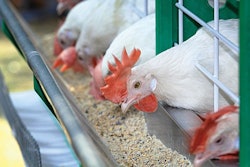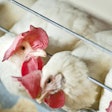
How China and other factors will impact feed production in the next 12 months
At the beginning of 2020, no one could have predicted the unexpected challenges and uncertainty the year would bear. Now, moving into 2021, several of the prevailing issues will carry over to shape global feed production.
In Feed Strategy’s 2021 Feed Industry Outlook report, economists and feed industry stakeholders weigh in on the trends and topics to keep an eye on over the next 12 months.
-
Rising feed costs
For many years, the U.S. poultry and livestock industries have benefitted from relatively low grain costs compared to the drought-induced high prices of 2012. However, in 2021, corn and soybean meal prices are set to spike in the first quarter of the year.
Despite tracking as the second-largest harvest ever, the total 2020 U.S. corn and soybean yield has been impacted by crop losses in Iowa, a key grain-producing state, caused by the August derecho and reduced soybean planting. FarmEcon LLC president Thomas Elam predicts corn and soybean meal prices will increase by about 10% in 2021.
Meanwhile, U.S. soybean exports to China jumped significantly in 2020 as Brazilian supplies waned, a trend expected to continue as the world’s largest pork producer restocks its herd and poultry production remains strong.
“We expect U.S. grain futures of $4.25/bushel of corn and $375/ton soybean meal prices as Chinese demand for feed grows as it rebuilds it hog herd,” reports Will Sawyer, lead economist – animal protein, CoBank.
Mark Jordan, executive director of LEAP Market Analytics, feels there should be enough of a supply buffer — and uncertainty on the demand-side — to limit the risk of the prices rising much further.
“The price pinch is probably going to come in the January-February-March period when China transitions from receiving all of their soybeans from the United States to transitioning back to South American soybeans,” says Paul Hughes, chief economist, IHS Markit Food and Agricultural Commodities Economics.
Hughes suggests China may also begin buying U.S. dried distiller’s grain with solubles (DDGS), which adds “another bullish element because that’s going to take DDGS out of the U.S. feed rations and will help keep the U.S. soybean crush at reasonably high levels.”
-
Effects of the COVID-19 pandemic
There are two ways the COVID-19 pandemic will continue to impact the global feed industry: employee safety and animal protein demand.
“Even though the animal feed industry has proven to be quite resilient in the COVID-19 crisis when compared to other economic sectors, the current pandemic — and risk of other pandemic outbreaks — will continue to affect the animal feed industry in 2021,” says Erik Visser, Hamlet Protein CEO.
Throughout the value chain, feed industry stakeholders must implement procedures, training and equipment to protect employees and prevent the spread of the virus, and to maintain their production and service levels.
“There are no hard and fast solutions to getting through the problems that persist, but companies can be prepared by thoroughly communicating action plans to workers and being as flexible as possible in addressing their concerns and protecting their well-being and safety,” Jordan advises.
Down the value chain, much like in the early weeks of the outbreak, processing disruptions in packing plants will continue to drive price levels and earning potential in markets, Visser says.
“There is definitely the potential for supply chain disruptions because of a resurgence in COVID-19 infections that appears to be happening right now, at least throughout the Northern Hemisphere,” Hughes notes.
Dave Taylor, Borregaard’s Americas area business manager for feed, cites COVID-19’s “wild card factor” since global economies lack the experience to make predictions and the human reaction to the virus, i.e., resisting protective measures, has become somewhat unpredictable.
“The impact this has on the feed industry is difficult to predict,” Taylor says. “Although the feed industry has not been hit nearly as hard as some other industries, there have been impacts as consumer behavior is shaped by the pandemic. As producers struggle to anticipate trends, so too will the feed industry struggle to keep producers adequately supplied.”
Given the uncertainty, Jordan suggests the agri-food industry display caution in investments and flexibility in their response as challenges arise.
“It’s probably wise to remember that now isn’t the time to sink huge chunks of capital into bold new projects and initiatives that might be innovative, but could take years to pay off,” he says.
“Getting through the next couple of years — hopefully to a post-COVID world — feels more like a simple matter of survival,” Jordan adds. “Companies should keep their powder dry to get through some of the challenges that remain for the year or more ahead.”
-
African swine fever (ASF) shapes export, protein markets
After the devastation ASF has wreaked on the Chinese swine sector since August 2018, the country is now rapidly restocking its hog herd, confident it can manage the virus due largely in part to its major investments in modern, commercial swine operations, with its sights set on a self-sufficient pork supply.
For now, the countries exporting pork and other animal proteins to China to offset the demand ASF created have profited. However, in the next three to five years, this will likely not be the case. According to an October 2020 Rabobank report, China could return to 95% self-sufficiency in pork production by 2025. In the near term, it estimates 2021 Chinese pork production will increase by 10% over 2020 volumes, which is expected to result in a 20 to 30% drop in imports.
“To put this in perspective, a drop of this magnitude equals about 10% of global pork trade or more than is imported by all but the top two importers,” the report said. “With five countries responsible for 85% of total pork imports annually, it may be increasingly difficult to redistribute the pork no longer needed by China.”
Sawyer notes that this shift risks an oversupply of U.S. pork if exports to other markets, primarily in Asia and Latin America, are unable to absorb it.
Meanwhile, ASF continues to spread through Europe, with numerous incidents of the virus being found in wild boars in Germany, which threatens Europe’s top pork producer.
“Where China is on the road to recovery, concerns in Europe — Germany and Poland — are increasing,” Visser says. “The impact on feed volumes and pork pricing varies strongly per country and 2021 will see markets on the winning and losing side. Without effective vaccinations available globally, animal disease outbreaks will disrupt supply chains.”
-
Market volatility
The lingering and substantial effects of both the COVID-19 and ASF viruses will continue to spur volatility in the agri-food sector.
“[Volatility] will result in shifts in volumes between markets and varying price and profitability levels of producers, which in turn will affect the demand for feed and feed additives,” Visser says.
The feed industry’s greatest challenges will be protecting their margins against commodity price volatility, whether driven by the supply of feed ingredients or demand for finished products, explains Jeff Hernandez, U.S. Bank corporate banking relationship manager, food & beverage.
He suggests producers hedge risk by utilizing a variety of risk management tools, including pairing purchase and sales contracts, and utilizing commodity hedging strategies to limit commodity price risk.
“Continuos volatility of demand has climbed to unheard-of levels in 2020 due to COVID-19 not only domestically but internationally,” Sawyer says. “This has driven very clear and significant winners and losers both regionally and by species and necessitates increased customer diversification by producers.”
Visser suspects this will also drive further industry consolidation across the supply and demand side of the animal feed industry.
-
Consumer demands and preferences
Accelerating an existing trend, COVID-19 has sparked increased consumer interest in the food supply chain.
Taylor feels consumers have a growing desire for transparency in where their food comes from and how their meat, milk and eggs are produced, which he believes has been heightened by the pandemic.
In turn, this will lead to increased demands on sustainable production, animal welfare and vegetarian or antibiotic-free animal diets, Visser says.
“Feed producers should not wait to act until government regulations are imposed, but make sure they are ready to adjust their supply chain to meet market demands,” Visser suggests.
Hernandez agrees: “The feed industry must find ways to maximize nutrition and efficiency while providing an ingredient list that is appealing to consumers.”
Feed industry stakeholders should also watch consumer protein consumption trends, particularly related to animal protein alternatives gaining market share. Younger consumers, for example, are more apt to consume meat alternatives, not for ideological or health reasons, but simply because they view plant-based meat alternatives as another centerplate protein option.
“We see ‘fake meats’ making significant progress with regard to scaling and cost efficiency will allow it to make further inroads into marketing channels historically dominated by traditional meat and poultry products,” Jordan says.
Visser asserts that though vegetarian, flexitarian and vegan diets are becoming more popular with certain demographics, on a global scale, animal protein consumption will continue to grow in 2021.
Top challenges nutritionists will face in 2021
Hamlet Protein CEO Erik Visser identified four additional feed industry trends set to influence 2021 feed production and offers tips for planning ahead.
- Reduced antibiotics usage driven by government and consumers
How to prepare: No single product can replace antibiotics, so a multi-faceted approach is required. Ample research on the use of alternatives is available, i.e., the experience European nutritionists have formulating antibiotic-free diets.
Solution: Optimize nutrition and vaccination programs coupled with good farm management and biosecurity measures
- EU Zinc Oxide (ZnO) restrictions effective 2022
How to prepare: Review possible adjustments of management practices and nutritional modification of diets and test different diet compositions.
Solution: Lower protein levels and reduction of the buffer effect of the diets, use of feed additives that stimulate gut health or reduce pathogen pressure, e.g., organic acids or fiber
- Cost control with shifting ingredient prices & demands on diet composition
How to prepare: Feed manufacturers and nutritionists will ultimately be concerned with ingredients and finished feed costs; therefore, increasing their focus on the sourcing of raw materials. Develop precision feeding strategies; secure availability and quality of ingredients.
Solution: Increases in reliable, high-quality feed additives and ingredients will help alleviate any animal-related issues
- Maximizing livestock’s genetic potential
How to prepare: Nutrient supply in early life determines the utilization of the genetic potential during an animal’s productive life. On-farm performance-trials, coupled with expert advice, can provide producers with insights on improvement opportunities.
Solution: Invest in designing feeding practices and diet composition with a focus on young animal nutrition















